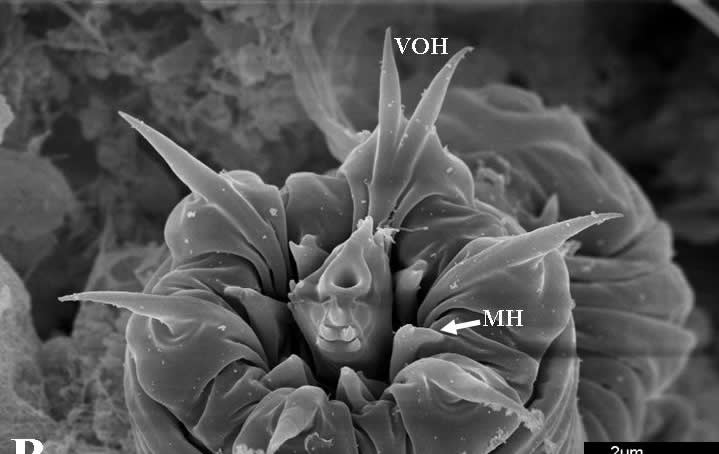

Nematomorpha
Nematomorpha or commonly known as Horsehair worms or Gordian worms are parasites of arthropods. The adults are long and thin free living worms that resemble nematodes. The larvae are parasitic in arthropods such as beetles, crickets, cockroaches and mantids. About 300 species have been described. Over the years we have been exploring the ecology, natural history and taxonomy of these strange and intriguing worms! See also Ben Hanelt’s nematomorph page who was the first person to domesticate the life cycle of these parasites!
Adult nematomorphs emerging from their hosts: Upper photographs Gordius difficilis emerging from its host Pterostichus melanarius (Carabidae: Coleoptera); lower photographs female Gordionus sp. emerging from an Amara alpine (Carabidae: Coleoptera) and a laboratory over infected variable field cricket, Gryllus lineaticeps with Paragordius varius.
Also see video of emerging P. varius from Gryllus lineaticeps!
Upper photographs free living Chordodes morgani, and showing “leopard pattern” which is present in some specimens; lower photographs free living Gordius difficilis female laying eggs, and egg strings of Chordodes albibarbatus from Africa!
Upper photographs SEM of anterior and posterior ends of free living male and female Gordius difficilis; lower photographs light micrographs of posterior region of free living female and male Paragordius varius, and male Chordodes morgani.
SEM of the internal anatomy of Gordius difficilis; note large ventral nerve chord, small intestine and reduced pseudocoel.
Free living male and female nematomorphs mating; note the sperm drop.
SEM of sperm emerging from a free living male Gordius difficilis and sperm deposited on the posterior end of a female.
Free living female Paragordius varius laying egg strings!
Egg strings deposited by Chordodes morgani!
Upper SEM of eggs, and photograph of egg string of Gordius difficilis next to a trichopteran larva; lower photographs developing larvae of Gordius difficilis.
Developing and free living larvae of Chordodes albibarbatus. The adult worms were collected in the village of Bawa from a small un-named river which is in the Menoua River Drainage in the West Province of Cameroon, and the female layed eggs at Cedar Point Biological Station!
See also video of a larva Chordodes albibarbatus!
Upper photographs cyst of Gordius robustus in the intestine of a cricket frog and cyst of Chordodes morgani in the tissue of a snail; lower photographs cyst of Gordius difficilis in snail tissue and cross section of a Gordius difficilis cyst in an earthworm (H& E).
A new Chordodes sp. from Kenya reared at the OSU parasitology laboratory in three different species of crickets. This species was originally collected as cysts in the snail Biomphalaria sudanica from Kenya by Ben Hanelt. Female Chordodes sp. laying eggs. Cuticle of male Chordodes sp. Laboratory reared eggs, larvae, and cysts of the new species of Chordodes from Kenya.
A new parthenogenic Paragordius sp. reared in crickets at the OSU parasitology laboratory. This species was originally collected as cysts in the snail Biomphalaria sudanica from Kenya, Africa by Ben Hanelt and is the first record of a parthenogenic nematomorph! Laboratory reared female worm laying eggs, and laboratory reared larvae and cysts.
Rearing crickets and snails for nematomorph infections: cricket eggs, newly hatched crickets, infected crickets in cages. Six species of snail used in experimental infections. These include (A) Physa gyrina (NA); (B) Biomphalaria sudanica (AF); (C) Biomphalaria glabrata (SA); (D) Gyraulus parvus (NA); (E) Planorbella trivolvis (NA); (F) Stagnicola elodes (NA).
A parasite is not a parasite is not a parasite is not a parasite . . .